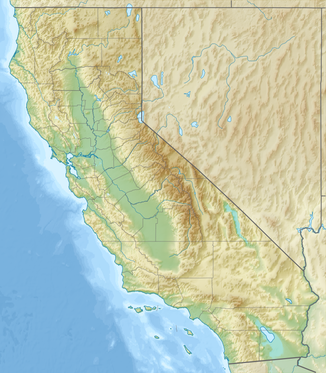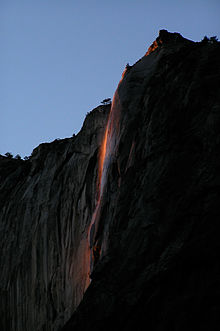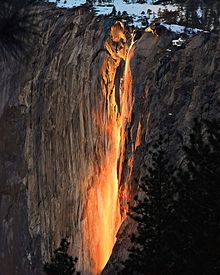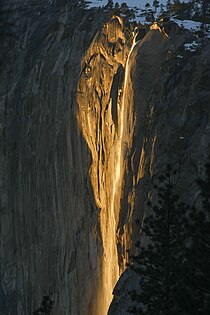Horsetail Fall (Yosemite)
| Horsetail Case / El Capitan Case | ||
|---|---|---|
|
Horsetail Fall (location of the waterfall on El Capitan) |
||
| Coordinates | 37 ° 43 '44.8 " N , 119 ° 37' 42.2" W | |
|
|
||
| place | Yosemite National Park , California , USA | |
| Estuarine waters | seasonal inflow to the Merced River | |
The Horsetail Fall (formerly El Capitan Fall ) is located in Yosemite National Park in California and is a seasonal waterfall that only carries water for a few weeks between December and April. The waterfall is located on the east side of El Capitan mountain . Under suitable weather conditions, the waterfall glows orange and red in the setting sun in February. This natural spectacle is often referred to as the “Firefall” based on the artificially created event Yosemite Firefall .
Surname
Due to the seasonal limitation and the small amount of water, the waterfall is not shown in older maps. An older name for the waterfall is El Capitan Fall because of its location .
There are various explanations for the name Horsetail Fall , by which the waterfall has been known almost everywhere in recent years. If one looks at the eastern half of El Capitan, one can see with imagination in the mountain silhouette a powerful galloping horse with the waterfall at the point of the tail. Another explanation arises from the typification of waterfalls. In a Horsetail waterfall, the water stays in contact with the bedrock most of the time during the fall. The water starts at a small stream and widens as it descends steeply, creating quite a bit of fog in the lower area - a look similar to that of a ponytail.
description
The waterfall is fed by heavy rains and thawing snow. The catchment area, the east-sloping plateau area of El Capitan, is very small, which means that the waterfall is dry for most of the year. Often, if at all, only a slightly damp rock face is visible. Horsetail Fall is sometimes referred to as a short-lived waterfall due to its seasonal nature.
Depending on the source, the height of the waterfall is given as 1000 to 1570 feet (300 to 480 m) and depends on the amount of water.
Firefall
For a few days between mid and late February, the waterfall is illuminated by the setting sun in such a way that the illusion of a burning waterfall is created. It is unclear when this natural spectacle was observed for the first time. The first known photo of the “glowing” waterfall comes from the American photographer Ansel Adams . It was recorded in 1940, then in black and white. It was not widely used and, because of its lack of color, received relatively little attention. The waterfall became famous as "Firefall" when the photographer Galen Rowell documented it in 1973 in National Geographic magazine . Since then, pictures have been shared on social media and the number of photographers trying to capture the natural spectacle themselves has increased.
In order to be able to view the natural spectacle, various requirements are required. The area of the waterfall needs to be lit from the right direction by the setting sun. This is only possible on a few days in February (especially the third week of February). There must be a sufficiently thick blanket of snow on the mountain and the temperature during the day must be high enough to melt the snow. This is the only way to have enough water in the evening to supply the waterfall. The sun must also shine directly on the waterfall during sunset, so it must not be weakened by haze or clouds. Last but not least, the viewing location has to be right so that the effect comes into its own. As all requirements are not always met at the same time, the “Firefall” cannot be observed every year.
The viewing location must allow a clear view of the waterfall without trees disturbing the view. The best effect is achieved by looking at the rock wall as grazingly as possible and the rock itself does not glow in the photo. The photographer Aaron Meyers describes three particularly suitable places on his website. The most famous spot is a small clearing near the picnic area on Northside Drive, which is also the closest location to the waterfall. Rowell's photo was also taken at this point in 1973. The other locations are on the banks of the Merced River near Southside Drive. Massive impairment of the sensitive vegetation by more than 2000 photographers in the bank area led to the park administration closing the latter areas in February. Neither parking nor stopping for loading and unloading is permitted on the two access roads.
Under ideal conditions, the evening spectacle can last up to 10 minutes. The exact times were calculated by Meyers and also published on his website. Shortly before sunset, the sun illuminates a relatively wide strip on the rock face. As the sun disappears further and further behind the ledge of El Capitan, this strip becomes increasingly narrow starting from the left side, and at the same time the light turns yellow, then first orange to red. At the end of the spectacle, only the waterfall itself is illuminated in red.
- Change of lighting during sunset on February 14, 2008
Web links
- Bill Woolf: Yosemite Horsetail Falls. In: vimeo. October 3, 2015, accessed October 18, 2020 (Video and photos from the Firefall on February 14, 2008).
Individual evidence
- ↑ a b Waterfalls. Yosemite National Park, July 16, 2020, accessed October 16, 2020 .
- ↑ Kevin Drum: Why did no one notice Yosemite's Horsetail "firefall effect" before 1973? In: Mother Jones. Retrieved October 17, 2020 (American English).
- ↑ Suzanne Swedo: Hiking Waterfalls Yosemite National Park: A Guide to the Park's Greatest Waterfalls . Rowman & Littlefield, 2019, ISBN 978-1-4930-3449-9 ( google.de [accessed October 15, 2020]).
- ↑ Michael Osborne: Granite, Water, and Light: The Waterfalls of Yosemite Valley . Ed .: Yosemite Conservancy. Heyday Books, 2009, ISBN 978-1-59714-099-7 , pp. 36 (English, google.de [accessed October 15, 2020]).
- ↑ San Luis Obispo California Polytechnic State University, Twitter Twitter: 12 Types of Waterfalls to See in Your Lifetime. Retrieved October 16, 2020 .
- ↑ Horsetail Falls, California, United States - World Waterfall Database. World Waterfall Database, March 19, 2017, accessed October 16, 2020 .
- ↑ About Horsetail Falls, One of Yosemite's Ephemeral Waterfalls. Kids discover, June 25, 2014, accessed October 10, 2020 .
- ↑ a b James Kaiser: The Natural Firefall, Horsetail Fall • Yosemite Firefall. Retrieved October 16, 2020 (American English).
- ↑ a b Firefall in Yosemite: The glowing waterfall on El Capitan. In: Explore Magazine. Retrieved on October 16, 2020 (German).
- ↑ a b How to Photograph Yosemite's Dazzling 'Firefall'. February 16, 2017, accessed October 16, 2020 .
- ↑ Horsetail Falls - The Natural Firefall in Yosemite. In: World of Waterfalls. Retrieved October 17, 2020 (American English).
- ↑ a b Horsetail Falls 2020 Date & Time Predictions (Yosemite National Park) - Aaron M Photography Blog. Retrieved October 17, 2020 (American English).
- ↑ Horsetail case. Yosemite National Park, accessed October 18, 2020 .









